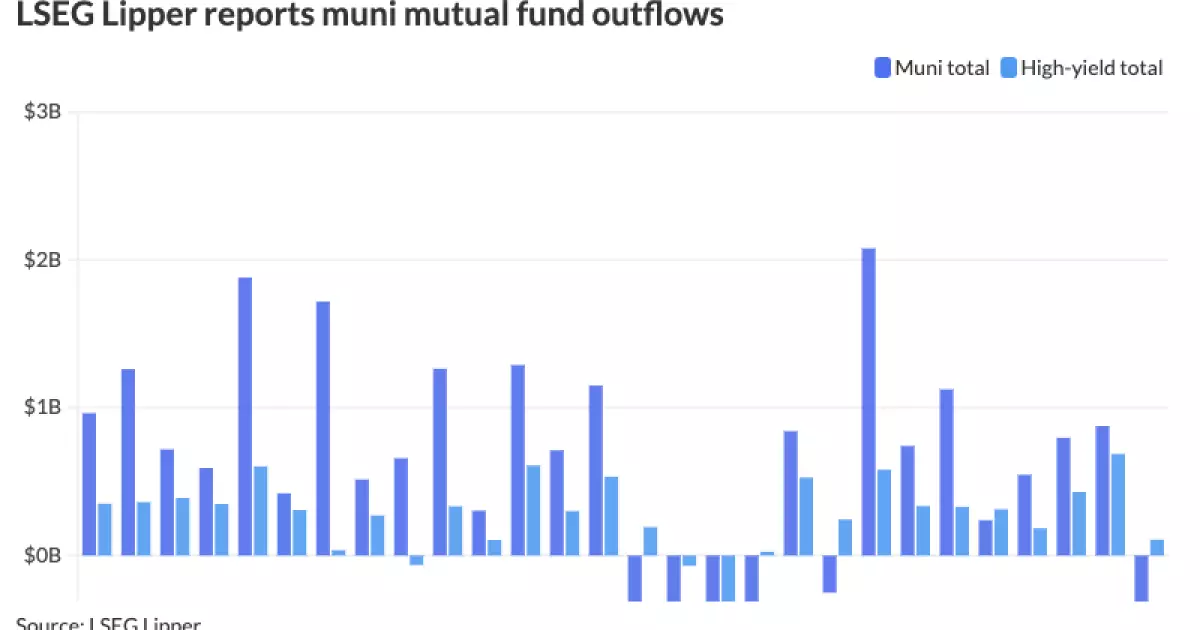The state of municipal bonds has become a troubling reflection of broader economic patterns, with recent data illuminating several distressing trends. Municipalities are experiencing significantly weakened performance, evidenced by escalating Treasury yields and fluctuating equities. As financial analysts assess the situation, it becomes clear that the imbalance of supply versus demand is not merely cyclical but symptomatic of deeper structural weaknesses within the bond market. It’s a canary-in-the-coal-mine scenario, raising questions about the sustainability and future of this traditionally stable investment avenue.
A Deteriorating Demand Amid Rising Supply
The municipal bond market is currently inundated with new supply that overwhelms demand, a sentiment echoed by Kim Olsan, a senior portfolio manager. The phrase “more supply than demand” should send shivers down the spine of every bond investor. This is a pressing concern; as the market braces for tax season, it’s apparent that redemptions are not contributing to any momentum in recovery. The fundamentals, rather than signaling improvement, seem to indicate stagnation as investors grapple with light redemptions and increased issuance. A mention of a 20-basis point adjustment on the long end of the curve isn’t just a number; it’s indicative of a drastic repositioning as multiple sellers pour their properties into the market, amplifying downward pressure.
The Ever-Growing Volatility
Volatility is the silent killer of investment confidence, and currently, the municipal bond market isn’t faring well. Jeff Timlin, managing partner at Sage Advisory, articulated how market fluctuations have intensified anxiety among retail investors. It’s no secret that the “no holds barred” policy emerging from Washington is creating ripples of uncertainty not just domestically but also on a global scale. The aggressive maneuvering of Treasury yields is triggering panic about municipal bonds, which often can’t withstand the same violent price swings. The prudent investor’s strategy calls for a cautious approach, and this is undeniably becoming more necessary.
The Threat to Tax Exemptions
Current discussions regarding the municipal tax exemption add another layer of complexity and anxiety. The potentiality that these exemptions could be partially or entirely repealed isn’t just hypothetical; it’s looming. The implications are staggering—should these changes come to pass, the appetite for municipal bonds would evaporate, causing a severe decline in investment funds, from tax-free money markets to separately managed accounts. Jeff Lipton, a market strategist, points out the tepid interest from banks and how they are navigating rising costs in this environment. The idea that tax-exempt munis could suddenly become taxable is not just a trivial concern; it’s potentially catastrophic for municipal bond investors.
Strain on Infrastructure Investments
Even as demand wanes, America’s infrastructure is suffering from neglect, which highlights a paradox. On one hand, we have a pressing need for investment in public projects, and on the other, we face a financial landscape that discourages the very investments that could rejuvenate municipal bonds. Natural disasters are putting additional strain on infrastructure, making timely investments even more critical. Yet, as capital flows dwindle, the specter of underinvestment looms large over our roads, schools, and bridges. The irony is palpable: in a time when we desperately need strong infrastructure, financial constraints inhibit our ability to fund these essential projects, further weakening the economy.
The Secondary Market: A Warning Sign
The trading patterns in the secondary market provide additional insights into investor sentiment. With investors pulling out $373 million from municipal bond mutual funds in a week—a stark contrast to the previous week’s inflows—this trend should not be dismissed lightly. Should high-yield funds also see diminished interest, we might witness a ripple effect that leads to further decline in the municipal bond market. The data from LSEG Lipper suggests that this market segment is at a precarious juncture, and while some investors remain doggedly committed, such withdrawals aggregate into a broader narrative of retreat.
The Future: Rising Yields and Tepid Growth
Current yield curves signal a future where expectations of returns remain subdued. The recent cuts in the Municipal Market Data scale illustrate a market that is not merely stagnant but seems to be navigating treacherous waters. The alarming drop in the average yields across various maturities is an indicator that faith in recovery may be misplaced. With factors like increased supply, continued volatility, and uncertain fiscal policies clouding the outlook, it’s unlikely that this landscape will dominate favorable returns for the average investor anytime soon. If better times are to return, they will require a coordinated strategy that reassures investors rather than shocking them into withdrawal.
As the municipal bond market faces an array of ominous challenges, it is unequivocally imperative for investors—and policymakers alike—to recognize these warning signs before it’s too late. Ignoring them may result in devastating consequences for municipalities and investors, reminiscent of past financial crises.

